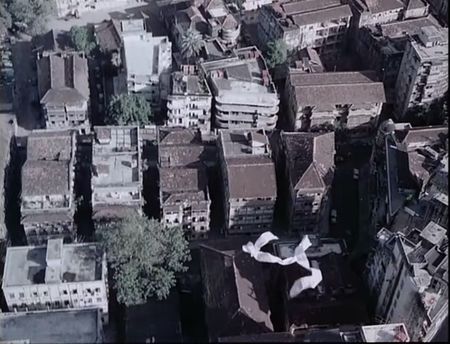Mani Kaul: Difference between revisions
No edit summary |
No edit summary |
||
| Line 1: | Line 1: | ||
Mani Kaul was an auteur filmmaker, teacher and influencer to a range of young students at the Film and Television Insititute, Pune. | Mani Kaul was an auteur filmmaker, teacher and influencer to a range of young students at the Film and Television Insititute, Pune. | ||
Agaman, or Arrival (1979) is one of his major films featuring Bombay city as a site, as a place to come to, to live, breathe, eat, raise, drop, chop, labour and die in. It achieves the effect of a "floating" gaze via several aerial shots, a technique that he compares to Mughal miniature painting in this essay, "View from Nowhere". <br> | Agaman, or Arrival (1979) is one of his major films featuring Bombay city as a site, as a place to come to, to live, breathe, eat, raise, drop, chop, labour and die in. It achieves the effect of a "floating" gaze via several aerial shots, a technique that he compares to Mughal miniature painting in this essay, "View from Nowhere". <br> | ||
| Line 10: | Line 9: | ||
The film features many exquisite shots of the city and its insides, including extended takes of goats being cut in the Deonar butchery, food produce arriving in Dadar, and land-filling construction activity at Colaba. The original cut of the film presented to Films Division had voice-over, which was subsequently replaced with a voiceless soundtrack for the final release. | The film features many exquisite shots of the city and its insides, including extended takes of goats being cut in the Deonar butchery, food produce arriving in Dadar, and land-filling construction activity at Colaba. The original cut of the film presented to Films Division had voice-over, which was subsequently replaced with a voiceless soundtrack for the final release. | ||
<br> | |||
Kaul emphasises the value of what is absent - the varjit, the forbidden - as perennially in ‘argument’ (vivadi) with what is narratively present... Later work strongly influenced by his study of Dhrupad music with Ustad Zia Mohiyuddin Dagar, Sangeet Samay Saar (14th C.) and Anandvardhan’s Dhwanyaloka, a 9th C. Sanskrit text on aesthetics exploring states of conscious perception... Among various non-Indian sources, has drawn from haiku poetry, the nouveau roman, mannerist painting, Bresson and Ozu. Recent return to fiction cinema draws mainly from Dostoevsky (Nazar, Idiot). Refused to sign the documentary Historical Sketch of Indian Women during the Emergency when its producers, Films Division, required him to change the last shot and the commentary. [https://indiancine.ma/MLK/info] | |||
Latest revision as of 20:28, 4 July 2019
Mani Kaul was an auteur filmmaker, teacher and influencer to a range of young students at the Film and Television Insititute, Pune.
Agaman, or Arrival (1979) is one of his major films featuring Bombay city as a site, as a place to come to, to live, breathe, eat, raise, drop, chop, labour and die in. It achieves the effect of a "floating" gaze via several aerial shots, a technique that he compares to Mughal miniature painting in this essay, "View from Nowhere".
File:Seen-from-nowhere mk ocr.pdf
See for example the "falling paper shot" at 12:52. [1]
The film features many exquisite shots of the city and its insides, including extended takes of goats being cut in the Deonar butchery, food produce arriving in Dadar, and land-filling construction activity at Colaba. The original cut of the film presented to Films Division had voice-over, which was subsequently replaced with a voiceless soundtrack for the final release.
Kaul emphasises the value of what is absent - the varjit, the forbidden - as perennially in ‘argument’ (vivadi) with what is narratively present... Later work strongly influenced by his study of Dhrupad music with Ustad Zia Mohiyuddin Dagar, Sangeet Samay Saar (14th C.) and Anandvardhan’s Dhwanyaloka, a 9th C. Sanskrit text on aesthetics exploring states of conscious perception... Among various non-Indian sources, has drawn from haiku poetry, the nouveau roman, mannerist painting, Bresson and Ozu. Recent return to fiction cinema draws mainly from Dostoevsky (Nazar, Idiot). Refused to sign the documentary Historical Sketch of Indian Women during the Emergency when its producers, Films Division, required him to change the last shot and the commentary. [2]

